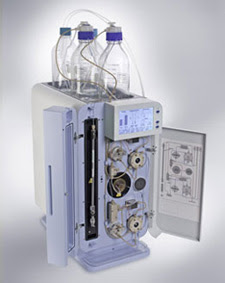Chromatography Quiz #7 Results
 We would like to congratulate the grand prize winner of our last newsletter’s Amino Acid Analysis Chromatography Quiz: Jaime Lee Palmer from Underwriters Laboratories!!!
We would like to congratulate the grand prize winner of our last newsletter’s Amino Acid Analysis Chromatography Quiz: Jaime Lee Palmer from Underwriters Laboratories!!!
She has won, and will shortly be receiving: a gift card for Barnes and Noble! Additionally, for this quiz all our participants will each be receiving a Smiley Face Sampler Box courtesy of The Popcorn Factory! Again, we would like to thank all of you for your submissions.
The correct answer for the modified Amino Acids chromatogram: the Trione reagent is oxidized. Either the reagent has been improperly stored (not under Nitrogen), or has been in extended contact with air.
Thank you!
Pickering Labs
Chromatography Quiz #8:
Identify the error made when running the Carbamates chromatogram below and win a prize! Simply email your answer as well as your full contact information to Rebecca at rlsmith@pickeringlabs.com by January 31st in order to win. You will receive email confirmation that your submission has been received. The troubleshooting answer and winner congratulations will be published in the next issue (to be anonymous, please notify Rebecca in submission).
Carbamate Analysis for US EPA Method 531.1
Pickering Column: 1846250 Carbamate Column, C18, 4.6 x 250 mm
Sample: Actual customer’s 531.1 standard at 10ppb
Normal Operating Conditions: (for reference only, condition changes may be reflected in chromatogram)
Column Temperature: 42 °C
Flow rate: 1 mL/min
Eluant Gradient:
|
TIME
|
WATER
|
MeOH %
|
|
0
|
85
|
15
|
|
1
|
85
|
15
|
|
44
|
25
|
75
|
|
44.1
|
0
|
100
|
|
49
|
0
|
100
|
|
49.1
|
85
|
15
|
|
57
|
85
|
15
|
Post-column conditions:
Reagent 1: Hydrolysis reagent CB130
Reagent 2: 100 mg of OPA, 2 g Thiofluor™ in 950 mL of CB910
Reactor 1: 100 °C, 0.5 mL
Reactor 2: ambient. 0.1 mL
Reagent flow rates: 0.3 mL/min
Detection: Fluorometer ex 330 nm, em 465 nm
Full Chromatogram:
Enlarged View:
Further Enlarged View:
For an example of a Good Carbamate Chromatogram, click here





